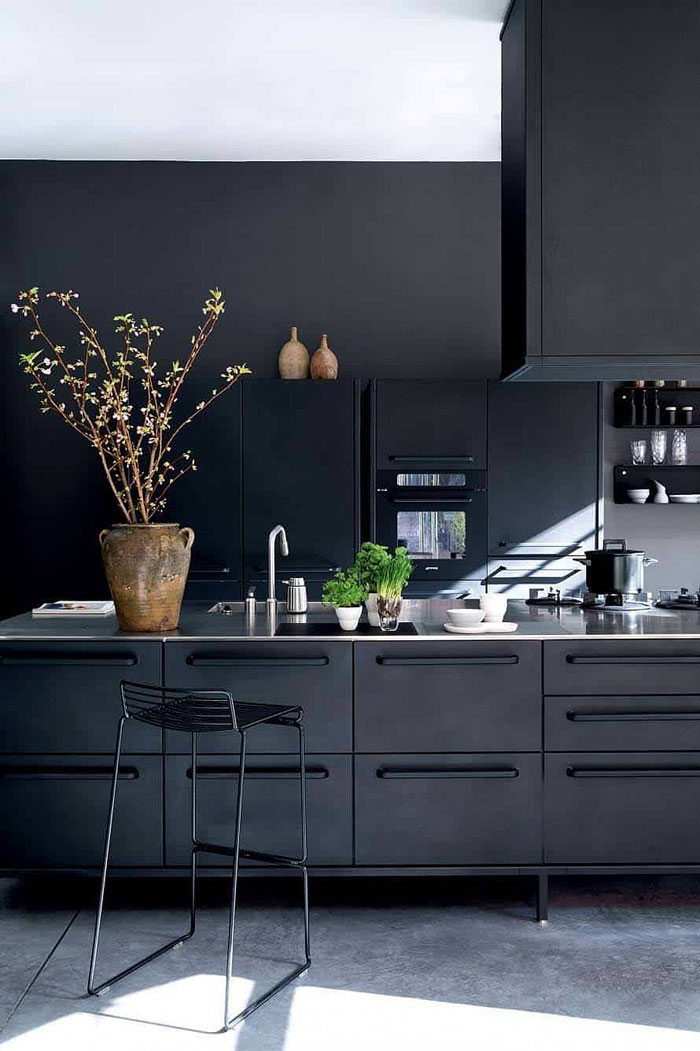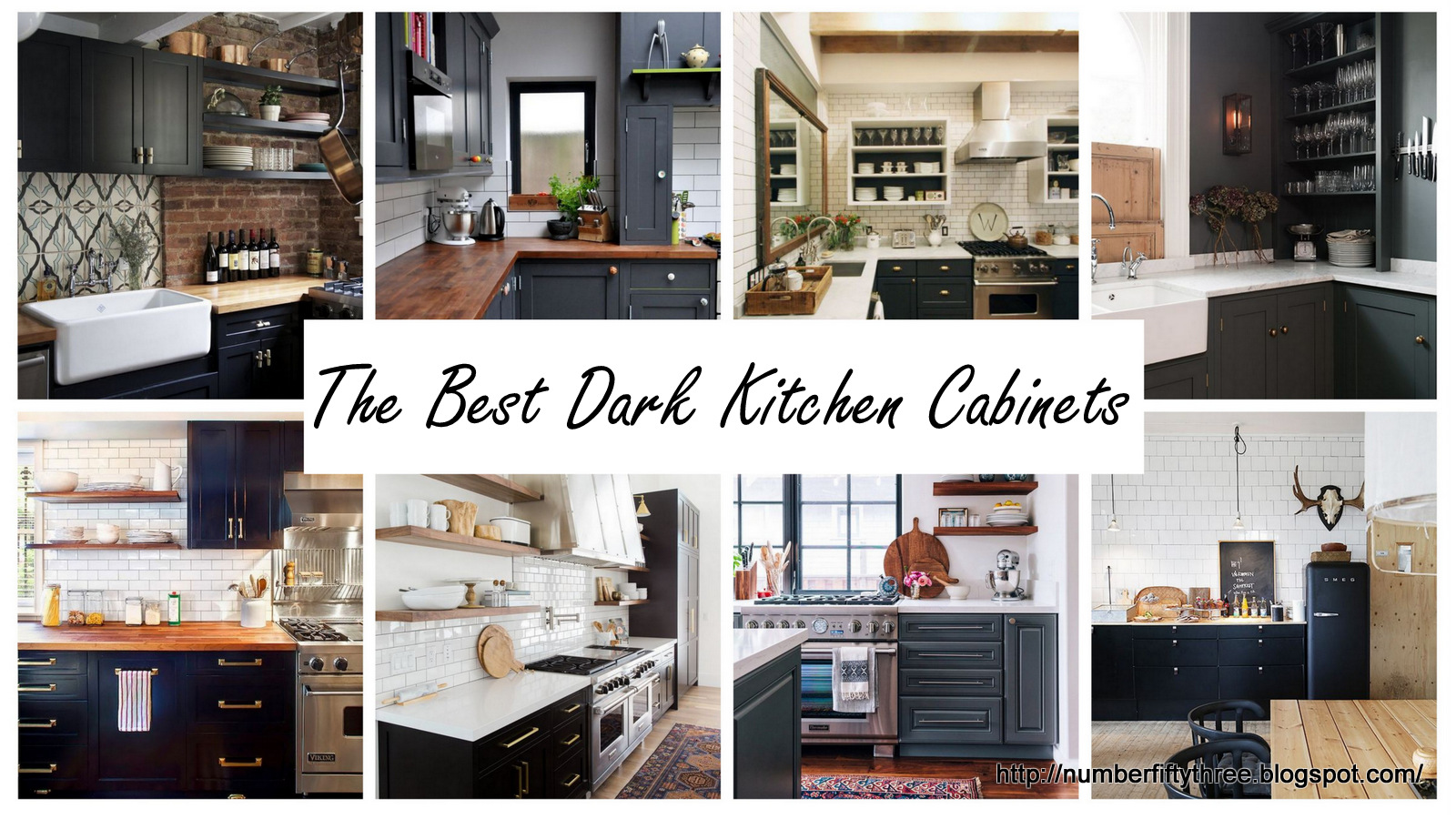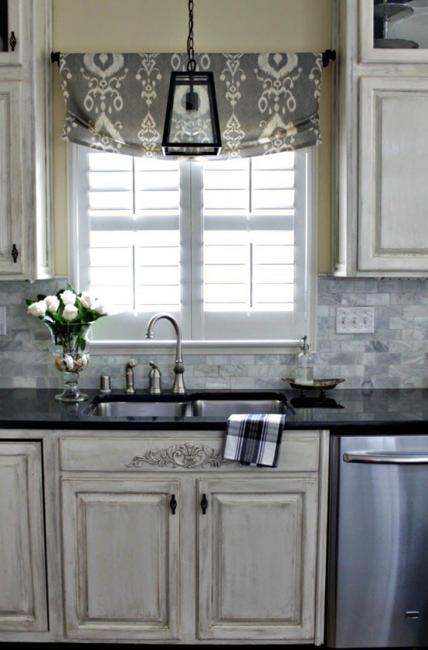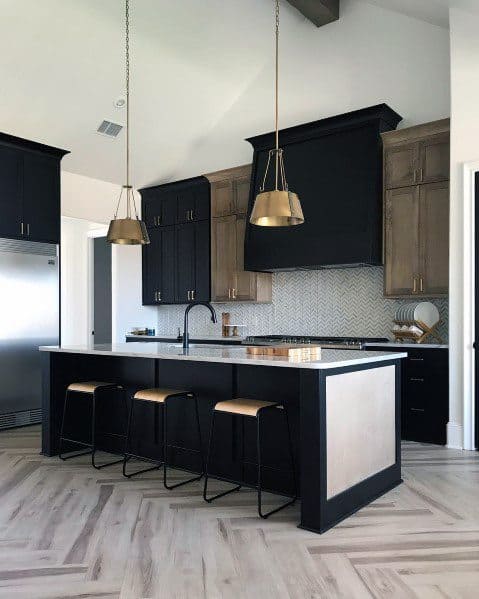Dark kitchen cabinets can add a touch of elegance and sophistication to any kitchen space. They create a striking contrast against lighter walls and countertops, and their rich tones can make a bold design statement. However, decorating around dark cabinets requires careful planning to balance the overall aesthetic and ensure the space remains inviting and functional. This comprehensive guide will explore various decorating ideas and strategies to complement dark kitchen cabinets, from color coordination to lighting and accessories.

Choosing the Right Countertops
Light-Colored Countertops
Pairing dark kitchen cabinets with light-colored countertops is a classic approach that creates a pleasing contrast and helps balance the room’s overall aesthetic. Materials like white marble, quartz, or light granite can brighten up the space, making it feel more open and airy. The light countertops reflect natural and artificial light, enhancing visibility and creating a fresh, clean look.
Warm-Toned Countertops
Warm-toned countertops, such as beige, tan, or creamy hues, can add a cozy and inviting feel to kitchens with dark cabinets. These colors complement the richness of dark wood or painted cabinets, creating a harmonious and balanced design. Materials like butcher block or light wood can add a touch of warmth and texture, making the kitchen feel more homey and comfortable.

Bold and Patterned Countertops
For a more dramatic look, consider bold and patterned countertops that make a statement. Countertops with intricate veining or bold colors, such as deep greens or blues, can add a unique touch to the kitchen. When using bold patterns, ensure that the overall design remains cohesive by keeping other elements simple and understated. This approach works well in modern and eclectic kitchens, adding personality and flair.
Matching Dark Countertops
Matching dark countertops with dark cabinets can create a sleek and sophisticated look, especially in contemporary or minimalist kitchens. To prevent the space from feeling too heavy or dark, incorporate plenty of lighting and reflective surfaces. A high-gloss finish on the cabinets and countertops can help bounce light around the room, while strategically placed mirrors or metallic accents can add brightness and depth.

Incorporating Backsplash Ideas
Subway Tile Backsplash
A classic and versatile option, subway tile backsplashes can work beautifully with dark kitchen cabinets. White or light-colored subway tiles create a clean, timeless look that contrasts nicely with the cabinets. For a modern twist, consider using dark grout to highlight the tile pattern and add visual interest. Subway tiles are easy to clean and maintain, making them a practical choice for busy kitchens.
Mosaic Tile Backsplash
Mosaic tile backsplashes offer a unique and artistic touch to kitchen decor. With a variety of colors, shapes, and materials available, mosaic tiles can be customized to suit any style. Metallic or glass mosaic tiles can add a touch of glamour and reflect light, brightening up the space. When paired with dark cabinets, a mosaic backsplash can serve as a stunning focal point, drawing the eye and adding texture.
Natural Stone Backsplash
Natural stone backsplashes, such as marble, slate, or travertine, can add a touch of luxury and elegance to kitchens with dark cabinets. The natural veining and texture of stone create a beautiful contrast and add depth to the design. A light-colored stone backsplash can help balance the dark cabinets, while a darker stone can create a cohesive and sophisticated look. Ensure that the stone is properly sealed to prevent stains and damage.
Bold and Colorful Backsplash
For those looking to add a pop of color and personality to their kitchen, a bold and colorful backsplash can be a great choice. Vibrant tiles in shades of blue, green, or even red can create a lively and dynamic atmosphere. When using bold colors, consider keeping other elements in the kitchen neutral to avoid overwhelming the space. A colorful backsplash can add a fun and energetic vibe, making the kitchen a focal point in the home.

Selecting Flooring Options
Light Wood Flooring
Light wood flooring, such as oak or maple, can create a beautiful contrast with dark kitchen cabinets, adding warmth and balance to the space. The natural grain and texture of wood flooring provide a timeless and versatile look that complements various design styles. Light wood floors reflect light, making the kitchen feel more open and inviting, and they can help to visually expand smaller spaces.
Tile Flooring
Tile flooring offers a wide range of options, from classic ceramic and porcelain to natural stone. Light-colored tiles can brighten the kitchen and create a clean, modern look. Patterned or textured tiles can add visual interest and a unique touch. When choosing tile flooring, consider the overall color scheme and ensure that the tiles complement the dark cabinets while adding depth and dimension to the space.
Dark Wood or Tile Flooring
Dark wood or tile flooring can create a cohesive and sophisticated look when paired with dark kitchen cabinets. This combination works particularly well in larger kitchens or open-concept spaces, where ample natural light can prevent the room from feeling too dark. To maintain balance, incorporate lighter elements such as a light-colored backsplash, countertops, or walls. Using different textures and finishes can also add depth and interest.
Luxury Vinyl Plank Flooring
Luxury vinyl plank (LVP) flooring is a durable and versatile option that can mimic the look of wood or stone at a lower cost. LVP is available in a variety of colors and patterns, making it easy to find a style that complements dark kitchen cabinets. Light or medium-toned LVP can create a beautiful contrast and add warmth to the space. Its water-resistant properties make it a practical choice for kitchens, offering both style and functionality.

Enhancing with Lighting
Under-Cabinet Lighting
Under-cabinet lighting is an effective way to brighten up the kitchen and highlight the beauty of dark cabinets. These lights provide task lighting for countertops, making food preparation easier and safer. LED strip lights or puck lights can be installed under the cabinets to illuminate the workspace and create a warm, inviting ambiance. Under-cabinet lighting can also enhance the visual appeal of the backsplash and countertops.
Pendant Lighting
Pendant lighting adds both style and functionality to the kitchen, serving as a decorative element and providing focused illumination. Choose pendant lights with finishes that complement the dark cabinets, such as brushed nickel, brass, or black. Install them over kitchen islands or dining areas to create a focal point and enhance the overall aesthetic. Pendant lights come in various designs, from modern and sleek to vintage and industrial, allowing you to find the perfect match for your kitchen.
Recessed Lighting
Recessed lighting, or can lights, provides general illumination and helps to evenly light the kitchen. These lights are installed in the ceiling, creating a clean and unobtrusive look. Recessed lighting is particularly effective in kitchens with dark cabinets, as it can brighten the entire space without taking up visual space. Use a combination of recessed lights and other lighting fixtures to create a well-lit and balanced kitchen.
Accent Lighting
Accent lighting can highlight specific features in the kitchen, such as open shelving, artwork, or architectural details. LED strips or spotlights can be used to draw attention to these areas, adding depth and dimension to the design. Accent lighting creates visual interest and enhances the overall ambiance of the kitchen. When used strategically, it can make dark cabinets stand out and add a touch of sophistication.

Accessorizing for Style and Function
Decorative Hardware
Updating the hardware on dark kitchen cabinets is an easy way to add a touch of style and personalize the space. Choose handles and knobs that complement the cabinet color and overall design. Brass, brushed nickel, or matte black finishes can add a modern and elegant touch. Decorative hardware not only enhances the visual appeal but also improves the functionality of the cabinets.
Open Shelving
Incorporating open shelving into your kitchen design can balance the visual weight of dark cabinets and create an airy feel. Use open shelves to display decorative items, such as dishes, glassware, or cookbooks. Choose shelving materials that complement the cabinets, such as wood, metal, or glass. Open shelving adds a layer of texture and interest to the kitchen while providing practical storage.
Rugs and Mats
Adding rugs or mats to the kitchen can introduce color, pattern, and texture, making the space feel more inviting. Place a runner along the sink or prep area to add comfort and style. Choose rugs that are easy to clean and maintain, as kitchen floors can get messy. Patterns and colors that complement the dark cabinets and overall color scheme can tie the design together and add a cozy touch.
Decorative Items and Plants
Incorporating decorative items and plants can add personality and warmth to the kitchen. Use vases, bowls, or candle holders to introduce color and texture. Fresh herbs or potted plants can add a touch of greenery and life to the space. Decorative items should be carefully selected to complement the dark cabinets and avoid cluttering the countertops. A few well-placed pieces can enhance the overall aesthetic and create a cohesive look.

Coordinating Wall Colors
Light and Neutral Wall Colors
Light and neutral wall colors, such as white, beige, or soft gray, can create a beautiful contrast with dark kitchen cabinets. These colors make the kitchen feel more open and airy, balancing the richness of the cabinets. Neutral walls provide a clean backdrop that allows the dark cabinets to stand out and shine. This combination works well in both modern and traditional kitchens, creating a timeless and elegant look.
Bold and Vibrant Wall Colors
For a more dramatic and contemporary look, consider bold and vibrant wall colors. Deep blues, greens, or even dark gray can create a striking and sophisticated atmosphere. When using bold wall colors, ensure that the overall design remains balanced by incorporating lighter elements, such as countertops, backsplashes, or flooring. Bold walls can add personality and flair, making the kitchen a focal point in the home.
Two-Tone Walls
Two-tone walls can add depth and interest to the kitchen design. Use a darker color on the lower half of the walls and a lighter shade on the upper half to create a balanced look. This technique can help to visually break up the space and prevent the dark cabinets from overwhelming the room. Two-tone walls work particularly well in kitchens with high ceilings or architectural details.
Accent Walls
Creating an accent wall is a great way to add visual interest and highlight specific areas of the kitchen. Choose a wall to feature a bold color, wallpaper, or textured finish that complements the dark cabinets. Accent walls can serve as a focal point and add dimension to the space. This technique allows you to experiment with different colors and patterns without overwhelming the entire room.

Common Mistakes to Avoid
Overloading with Dark Elements
While dark cabinets can add elegance to the kitchen, overloading the space with too many dark elements can make it feel cramped and uninviting. Balance the design by incorporating lighter colors and reflective surfaces to brighten the room. Avoid using dark colors for walls, floors, and countertops simultaneously, as this can create a heavy and enclosed atmosphere.
Neglecting Lighting
Inadequate lighting can make a kitchen with dark cabinets feel dull and gloomy. Ensure that you have a mix of ambient, task, and accent lighting to illuminate the space effectively. Under-cabinet lighting, pendant lights, and recessed lighting can enhance visibility and highlight the beauty of the cabinets. Proper lighting is crucial to creating a warm and welcoming kitchen environment.
Ignoring the Overall Color Scheme
A cohesive color scheme is essential for a well-designed kitchen. Ignoring the overall color scheme can result in a disjointed and chaotic look. When decorating around dark cabinets, consider the color palette for walls, countertops, backsplashes, and accessories. Ensure that all elements work together harmoniously to create a balanced and aesthetically pleasing design.
Skipping Personal Touches
While focusing on the major design elements, don’t forget to add personal touches that make the kitchen feel like home. Incorporating decorative items, artwork, and plants can add warmth and personality to the space. Personal touches help to create a unique and inviting kitchen that reflects your style and preferences.

How can I brighten my kitchen with dark cabinets?
To brighten a kitchen with dark cabinets, incorporate light-colored countertops, backsplashes, and walls to create contrast and reflect light. Ensure ample lighting with a mix of ambient, task, and accent lighting, including under-cabinet and pendant lights. Use reflective surfaces, such as glossy finishes and metallic accents, to bounce light around the room. Adding mirrors or glass-front cabinets can also help to brighten the space.
What colors go well with dark kitchen cabinets?
Colors that go well with dark kitchen cabinets include light neutrals like white, beige, and soft gray, which create a clean and balanced look. Warm tones such as cream, tan, or light wood can add warmth and coziness. Bold colors like deep blue, green, or even dark gray can create a dramatic and sophisticated atmosphere. Ensure that the chosen colors complement the overall design and create a cohesive aesthetic.
How can I add a pop of color to my kitchen with dark cabinets?
To add a pop of color to your kitchen with dark cabinets, consider using colorful backsplashes, rugs, or accessories. Vibrant tiles, patterned backsplashes, or a bold accent wall can introduce color and personality. Decorative items such as vases, bowls, or artwork in bright hues can also add visual interest. Incorporating colorful plants or fresh flowers can bring a touch of nature and vibrancy to the space.
Are dark kitchen cabinets a good choice for small kitchens?
Dark kitchen cabinets can be a good choice for small kitchens if balanced with light colors and ample lighting. Use light-colored countertops, backsplashes, and walls to create contrast and make the space feel larger. Incorporate reflective surfaces and ensure adequate lighting to prevent the kitchen from feeling cramped. Dark cabinets can add depth and sophistication, making the small kitchen feel more luxurious.
What type of hardware works best with dark kitchen cabinets?
Hardware that works well with dark kitchen cabinets includes finishes like brushed nickel, brass, matte black, or chrome. These finishes create a striking contrast and add a touch of elegance. Choose handles and knobs that complement the cabinet style and overall design. Modern, sleek hardware works well in contemporary kitchens, while more ornate designs can enhance traditional or transitional styles.
How do I maintain and clean dark kitchen cabinets?
To maintain and clean dark kitchen cabinets, regularly dust them with a soft cloth to prevent the buildup of dirt and grime. Use a mild cleaning solution of water and gentle dish soap to wipe down the cabinets, avoiding harsh chemicals that can damage the finish. For stubborn stains, use a mixture of vinegar and water. Dry the cabinets thoroughly after cleaning to prevent moisture damage. Regular maintenance ensures that the dark cabinets remain beautiful and in good condition.

Related Posts:
- Kitchen Paint Colors With Walnut Cabinets
- How Much Is It To Replace Kitchen Cabinets
- Kitchen Cabinets French Country Style
- Knotty Kitchen Cabinets
- Laminate Peeling Off Kitchen Cabinets
- Kitchen Cabinet Support Legs
- Diy Old Kitchen Cabinets
- Kitchen Cabinet Bench Seat
- Kitchen With Oak Cabinets And Stainless Steel Appliances
- Galley Kitchen Cabinet Design